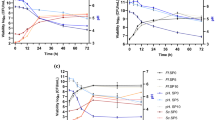Abstract
The tolerance to freeze–thaw stress of yeast cells is critical for frozen-dough technology in the baking industry. In this study, we examined the effects of soy peptides on the freeze–thaw stress tolerance of yeast cells. We found that the cells cultured with soy peptides acquired improved tolerance to freeze–thaw stress and retained high leavening ability in dough after frozen storage for 7 days. The final quality of bread regarding its volume and texture was also improved by using yeast cells cultured with soy peptides. These findings promote the utilization of soy peptides as ingredients of culture media to improve the quality of baker’s yeast.




Similar content being viewed by others
References
Coutinho C, Bernardes E, Felix D, Panek AD (1988) Trehalose as cryoprotectant for preservation of yeast strains. J Biotechnol 7:23–32
Hino A, Mihara K, Nakashima K, Takano H (1990) Trehalose levels and survival ratio of freeze-tolerant versus freeze-sensitive yeasts. Appl Environ Microbiol 56:1386–1391
Hirasawa R, Yokoigawa K (2001) Leavening ability of baker’s yeast exposed to hyperosmotic media. FEMS Microbiol Lett 194:159–162
Hirasawa R, Yokoigawa K, Isobe Y, Kawai H (2001) Improving the freeze tolerance of bakers’ yeast by loading with trehalose. Biosci Biotechnol Biochem 65:522–526
Hori G, Wang MF, Chan YC, Komatsu T, Wong Y, Chen TH, Yamamoto K, Nagaoka S, Yamamoto S (2001) Soy protein hydrolyzate with bound phospholipids reduces serum cholesterol levels in hypercholesterolemic adult male volunteers. Biosci Biotechnol Biochem 65:72–78
Izawa S, Sato M, Yokoigawa K, Inoue Y (2004a) Intracellular glycerol influences resistance to freeze stress in Saccharomyces cerevisiae: analysis of a quadruple mutant in glycerol dehydrogenase genes and glycerol-enriched cells. Appl Microbiol Biotechnol 66:108–114
Izawa S, Ikeda K, Maeta K, Inoue Y (2004b) Deficiency in the glycerol channel Fps1p confers increased freeze tolerance to yeast cells: application of the fps1Δ mutant to frozen dough technology. Appl Microbiol Biotechnol 66:303–305
Kaul SC, Obuchi K, Iwahashi H, Komatsu Y (1992) Cryoprotection provided by heat shock treatment in Saccharomyces cerevisiae cells: induction of a 33 kDa protein and protection against freezing injury. Cell Mol Biol 38:135–143
Morita Y, Nakamori S, Takagi H (2003) L-proline accumulation and freeze tolerance of Saccharomyces cerevisiae are caused by a mutation in the PRO1 gene encoding γ-glutamyl kinase. Appl Environ Microbiol 69:212–219
Murakami Y, Yokoigawa K, Kawai F, Kawai H (1996) Lipid composition of commercial baker’s yeast having different freeze-tolerance in frozen dough. Biosci Biotechnol Biochem 60:1874–1876
Myers DK, Joseph VM, Pehm S, Galvagno M, Attfield PV (1998) Loading of Saccharomyces cerevisiae with glycerol leads to enhanced fermentation in sweet bread doughs. Food Microbiol 15:51–58
Park J-I, Grant CM, Attfield PV, Dawes IW (1997) The freeze–thaw stress response of the yeast Saccharomyces cerevisiae is growth phase specific and is controlled by nutritional state via the RAS–cyclic AMP signal transduction pathway. Appl Environ Microbiol 63:3818–3824
Shima J, Hino A, Yamada-Iyo C, Suzuki Y, Nakajima R, Watanabe H, Mori K, Takano H (1999) Stress tolerance in doughs of Saccharomyces cerevisiae trehalase mutants derived from commercial baker’s yeast. Appl Environ Microbiol 65:2841–2846
Shima J, Sakata-Tsuda Y, Suzuki Y, Nakajima R, Watanabe H, Kawamoto S, Takano H (2003) Disruption of the CAR1 gene encoding arginase enhances freeze tolerance of the commercial baker’s yeast Saccharomyces cerevisiae. Appl Environ Microbiol 69:715–718
Takagi H, Iwamoto F, Nakamori S (1997) Isolation of freeze-tolerant laboratory strains of Saccharomyces cerevisiae from proline-analogue-resistant mutants. Appl Microbiol Biotechnol 47:405–411
Takenaka A, Annaka H, Kimura Y, Aoki H, Igarashi K (2003) Reduction of paraquat-induced oxidative stress in rats by dietary soy peptide. Biosci Biotechnol Biochem 67:278–283
Tanghe A, Van Dijck P, Dumortier F, Teunissen A, Hohmann S, Thevelein JM (2002) Aquaporin expression correlates with freeze tolerance in baker’s yeast, and overexpression improves freeze tolerance in industrial strains. Appl Environ Microbiol 68:5981–5989
Tsuruki T, Kishi K, Takahashi M, Tanaka M, Matsukawa T, Yoshikawa M (2003) Soymetide, an immunostimulating peptide derived from soybean β-conglycinin, is an fMLP agonist. FEBS Lett 540:206–210
Tsuruki T, Takahata K, Yoshikawa M (2004) A soy-derived immunostimulating peptide inhibits etoposide-induced alopecia in neonatal rats. J Invest Dermatol 122:848–850
Yokoigawa K, Sato M, Soda K (2006) Simple improvement in freeze-tolerance of bakers’ yeast with poly-γ-glutamate. J Biosci Bioeng 102:215–219
Acknowledgments
We are sincerely grateful to Ms. Sayuri Kitagawa for her constructive suggestion and useful information. This study was partly supported by the Bio-oriented Technology Research Advancement Institution (BRAIN).
Author information
Authors and Affiliations
Corresponding author
Rights and permissions
About this article
Cite this article
Izawa, S., Ikeda, K., Takahashi, N. et al. Improvement of tolerance to freeze–thaw stress of baker’s yeast by cultivation with soy peptides. Appl Microbiol Biotechnol 75, 533–537 (2007). https://doi.org/10.1007/s00253-007-0855-6
Received:
Revised:
Accepted:
Published:
Issue Date:
DOI: https://doi.org/10.1007/s00253-007-0855-6




